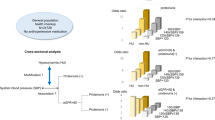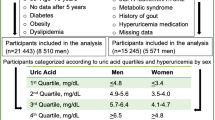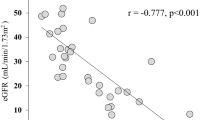Abstract
The role of serum uric acid (SUA) in the context of adverse cardiovascular events in hypertensive subjects is controversial. Additionally, the relationship between SUA and indices of target organ damage is not well defined in this setting. Towards this end, we studied 842 consecutive nondiabetic patients with stage I–II essential hypertension (office blood pressure=148/95 mmHg, aged 53.4 years), referred to our outpatient hypertensive unit within a period of 4 years. According to the urinary albumin excretion (UAE), the study population was classified into those with microalbuminuria [MA(+), UAE=20–200 mg/24 h, n=222] and those without MA [MA (−), UAE< 20 mg/24 h, n=620]. Moreover, according to the presence of left ventricular hypertrophy (LVH) the participants were subdivided into two additional groups: [LVH (+), n=305 and LVH (−), n=537]. SUA levels were higher by 0.4 mg/dl, (P=0.04) in group MA (+) compared with the group MA (−), while no difference was observed between groups LVH (+) and LVH (−) (P=NS). In the entire population, SUA was correlated with body mass index (BMI) (r=0.17, P<0.001), waist/hip ratio (r=0.3, P<0.001), office systolic blood pressure (SBP) (r=0.14, P<0.05), triglycerides levels (r=0.25, P<0.001), UAE (r=0.35, P<0.001) and HDL (r=−0.26, P<0.001). Multiple regression analysis demonstrated that SUA was significantly related with BMI, office SBP and UAE (P<0.05). In conclusion, increased SUA levels are associated with MA but not with LVH in essential hypertensive subjects. Whether these inter-relationships may elucidate the clinical positioning of augmented SUA in this setting remains to be clarified in future studies.
This is a preview of subscription content, access via your institution
Access options
Subscribe to this journal
Receive 12 digital issues and online access to articles
$119.00 per year
only $9.92 per issue
Buy this article
- Purchase on Springer Link
- Instant access to full article PDF
Prices may be subject to local taxes which are calculated during checkout
Similar content being viewed by others
References
European Society of Hypertension – European Society of Cardiology guidelines for the management of arterial hypertension. J Hypertens 2003; 21: 1011–1053.
Persky VW et al. Uric acid: a risk factor for coronary heart disease? Circulation 1979; 59: 969–977.
Lehto S, Niskanen L, Ronnemaa T, Laakso M . Serum uric acid is a strong predictor of stroke in patients with non-dependent diabetes mellitus. Stroke 1998; 29: 635–639.
Levine W et al. Serum uric acid and 11.5 year mortality of middle-aged women: findings of the Chicago Heart Association Detection Project in Industry. J Clin Epidemiol 1989; 42: 257–267.
Frohlich ED . Uric acid: a risk factor for coronary heart disease. JAMA 1993; 270: 378–379.
Ward HJ . Uric acid as an independent risk factor in the treatment of hypertension. Lancet 1998; 352: 670–671.
Wannamethee SG, Shaper AG, Whincup PH . Serum urate and the risk of major coronary heart disease events. Heart 1997; 78: 147–153.
Fessel WJ . High uric acid as an indicator of cardiovascular disease: independence from obesity. Am J Med 1980; 68: 401–404.
Brand FN et al. Hyperuricemia as a risk factor of coronary heart disease: the Framingham study. Am J Epidemiol 1985; 121: 11–18.
Culleton BF, Larson MG, Kannel WB, Levy D . Serum uric acid and risk for cardiovascular disease and death: the Framingham Heart Study. Ann Intern Med 1999; 131: 7–13.
Puig JG, Ruilope LM . Uric acid as a cardiovascular risk factor in arterial hypertension. J Hypertens 1999; 17: 869–872.
Jaques BC, Ginsberg MH . The role of cell surface proteins in platelet stimulation by monosodium urate crystals. Arthritis Rheum 1982; 25: 508–521.
Chapman PT et al. Endothelial activation in monosodium urate monohydrate crystal – induced inflammation: in vitro and in vivo studies on the role of tumor necrosis factor alpha and interleukin-1. Arthritis Rheum 1997; 40: 955–965.
Leoncini G et al. Microalbuminuria is an integrated marker of subclinical organ damage in primary hypertension. J Hum Hypertens 2002; 16: 399–404.
Sica DA, Weber D . The Losartan Intervention for Endpoint Reduction (LIFE) trial—have angiotensin receptor blockers come of age? J Clin Hypertens 2002; 4: 301–305.
The Joint National Committee on detection, evaluation and treatment of high blood pressure. The sixth report of the Joint National Committee on detection, evaluation and treatment of high blood pressure (JNC VI). Arch Intern Med 1997; 157: 2413–2446.
Schiller NB et al. Recommendations for quantitation of the left ventricular dimensions by two-dimensional echocardiography, American Society of Echocardiography Committee on standards, subcommittee on quantitation of two-dimensional echocardiograms. J Am Soc Echocardiogr 1989; 2: 358–367.
Schiller NB . Two-dimensional echocardiographic determination of left ventricular volume, systolic function, and mass. Summary and discussion of the 1989 recommendations of the American Society of Echocardiography. Circulation 1991; 84: 1280–1287.
Agrawal B, Berger A, Wolf K, Luft FC . Microalbuminuria screening by reagent strips predicts cardiovascular risk in hypertension. J Hypertens 1996; 14: 223–228.
Modan M, Halkin H, Karasik A, Lusky A . Elevated serum uric acid: a facet of hyperinsulinemia. Diabetologia 1987; 30: 713–718.
Kuusisto J, Mykkanen L, Pyorala K, Laakso M . Hyperinsulinemic microalbuminuria: a new risk indicator for coronary heart disease. Circulation 1995; 91: 831–837.
Modan M et al. Hyperinsulinemia: a link between hypertension, obesity and glucose intolerance. J Clin Invest 1985; 75: 809–817.
Niskanen L, Laakso M . Insulin resistance is related to albuminuria in patients with type II (non-insulin-dependent) diabetes mellitus. Metabolism 1993; 42: 1541–1545.
Saad MF et al. Racial differences in the relation between blood pressure and insulin resistance. N Engl J Med 1991; 324: 733–739.
Berry CE, Hare JM . Xanthine oxidoreductase and cardiovascular disease—molecular mechanisms and pathophysiologic implications. J Physiol 2004; 555(Part 3): 589–606.
Sesso HD et al. C-reactive protein and the risk of developing hypertension. JAMA 2003; 290: 2945–2951.
Kanellis J et al. Uric acid stimulates monocyte chemoattractant protein-1 production in vascular smooth muscle cells via mitogen—activated protein kinase and cyclooxygenase-2. Hypertension 2003; 41: 1287–1293.
Di Bello V et al. Microalbuminuria, pulse pressure, left ventricular hypertrophy, and myocardial ultrasonic tissue characterization in essential hypertension. Angiology 2001; 52: 175–183.
Dell’omo G et al. Blood pressure independent association of microalbuminuria and left ventricular hypertrophy in hypertensive men. J Intern Med 2003; 254: 76–84.
Ravera M et al. Microalbuminuria and subclinical cerebrovascular damage in essential hypertension. J Nephrol 2002; 15: 519–524.
Tsioufis C et al. Inter-relationships of microalbuminuria with the other surrogates of the atherosclerotic cardiovascular disease in hypertensive subjects. Am J Hypertens 2004; 17: 470–476.
Tsioufis C et al. Microalbuminuria is associated with unfavourable cardiac geometric adaptations in essential hypertensive patients. J Hum Hypertens 2002; 16: 249–254.
Tsioufis C et al. Relation of ambulatory blood pressure load with left ventricular geometry in untreated patients with mild-to-moderate hypertension. J Hum Hypertens 1999; 13: 677–682.
Tsioufis C et al. Microalbuminuria is associated with impaired arterial mechanics in essential hypertension. Am J Cardiol 2000; 86: 797–801.
Alderman MH, Cohen H, Madhavan S, Kivlighn S . Serum uric acid and cardiovascular events in successfully treated hypertensive patients. Hypertension 1999; 34: 144–150.
Staessen J . The determinants and prognostic significance of serum uric acid in elderly patients of the European Working Party on High Blood Pressure in the Elderly trial. Am J Med 1991; 90: 50S–54S.
Franse LV et al. Serum uric acid, diuretic treatment and risk of cardiovascular events in the Systolic Hypertension in the Elderly Program (SHEP). J Hypertens 2000; 18: 1149–1154.
Author information
Authors and Affiliations
Corresponding author
Rights and permissions
About this article
Cite this article
Tsioufis, C., Chatzis, D., Vezali, E. et al. The controversial role of serum uric acid in essential hypertension: relationships with indices of target organ damage. J Hum Hypertens 19, 211–217 (2005). https://doi.org/10.1038/sj.jhh.1001810
Received:
Accepted:
Published:
Issue Date:
DOI: https://doi.org/10.1038/sj.jhh.1001810
Keywords
This article is cited by
-
Association of serum uric acid with mortality and cardiovascular outcomes in patients with hypertension: a meta-analysis
Journal of Thrombosis and Thrombolysis (2021)
-
Gender-related differences in the association between serum uric acid and left ventricular mass index in patients with obstructive hypertrophic cardiomyopathy
Biology of Sex Differences (2016)
-
Hyperuricemia and Renal Risk
High Blood Pressure & Cardiovascular Prevention (2014)
-
The diverse associations of uric acid with low-grade inflammation, adiponectin and arterial stiffness in never-treated hypertensives
Journal of Human Hypertension (2011)
-
Serum Uric Acid Levels and Renal Damage in Hyperuricemic Hypertensive Patients Treated With Renin-Angiotensin System Blockers
American Journal of Hypertension (2010)



